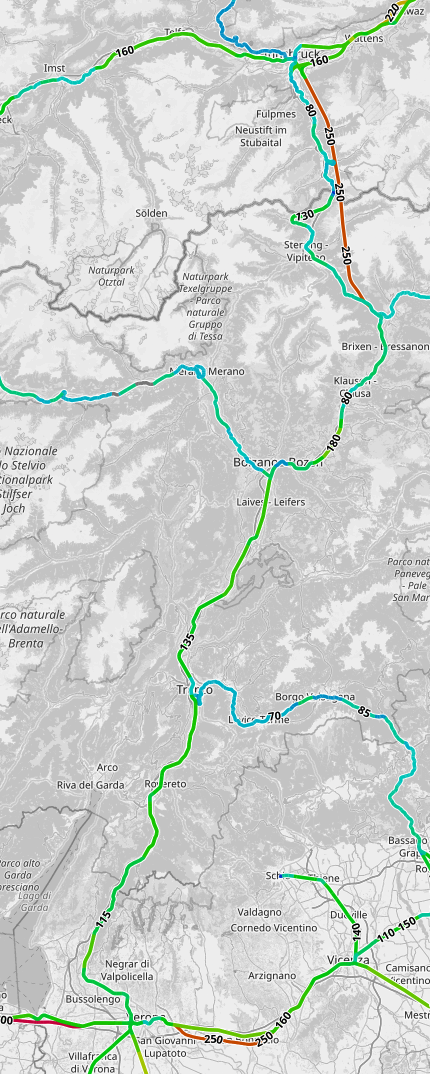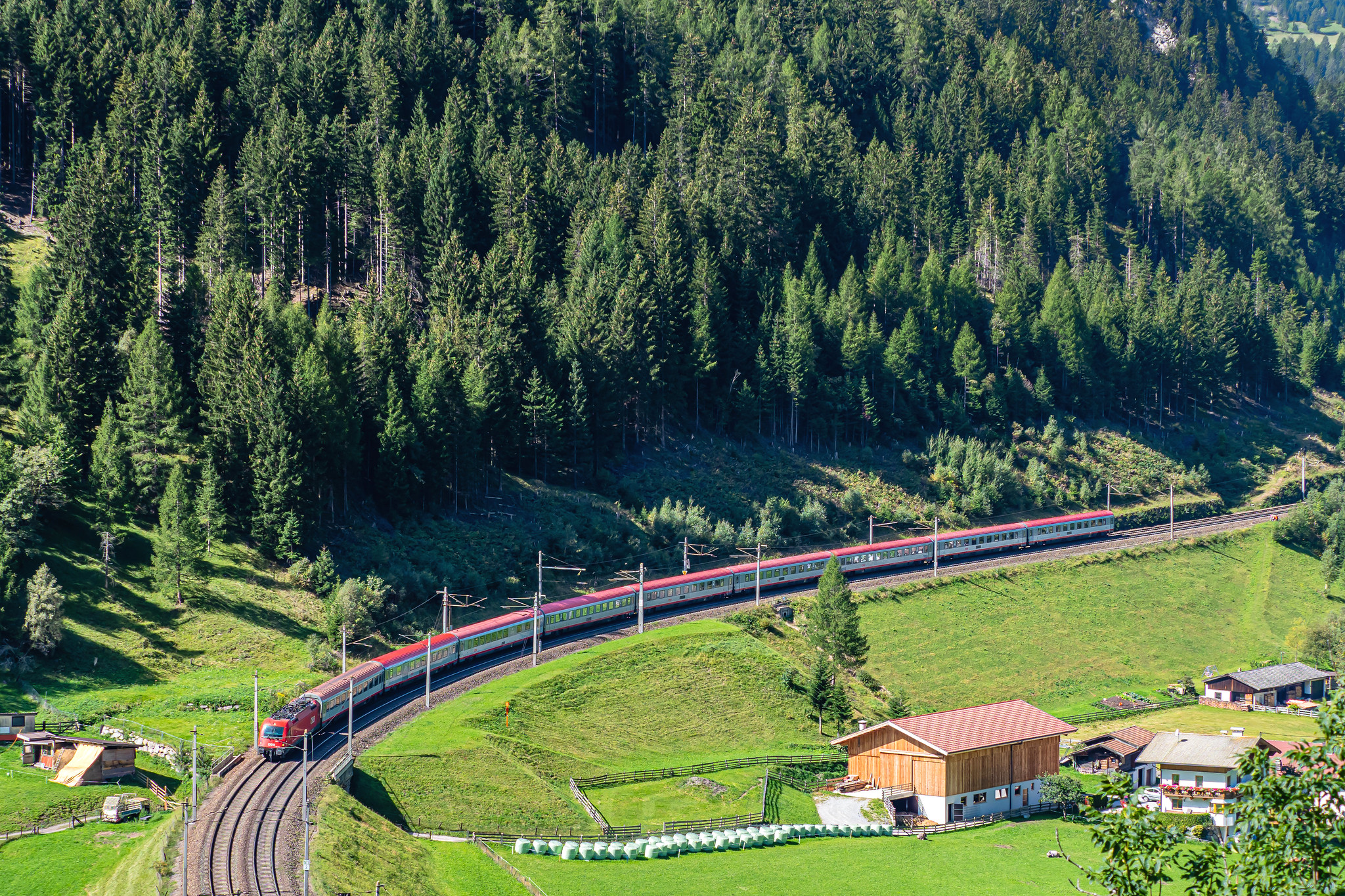Over on Mastodon, Gregor Herrmann pointed me towards this story in German publication Merkur about German, Austrian and Italian railways planning faster rail connections between München and Milano, and München and Roma. ORF and Die Presse covered the story in Austria, but here I am going to focus on the Merkur piece – and decrypt it.
 The gist of the Merkur story is right. There are plans to improve passenger services via the Brenner Pass. And at the moment, yes, to get to Milano or Roma from München you do need to change trains – either in Verona (for Milano) or Bologna (for Roma).
The gist of the Merkur story is right. There are plans to improve passenger services via the Brenner Pass. And at the moment, yes, to get to Milano or Roma from München you do need to change trains – either in Verona (for Milano) or Bologna (for Roma).
The problem from the off is the relatively long journey times – seven and a half hours to Milano and nine and a half hours to Roma – are not really simple to address very much in the short term.
The problem: there are rather large mountains in the way and the infra is quite low speed!
The map to the right here from openrailwaymap zooms in on the Innbruck-Verona section of the route, with the numbers indicating line speeds. You can see that the part climbing from Innsbruck is rated at only 80km/h.
And sorry, the 250km/h part is still only in planning – that is the Brenner Base Tunnel that is due to open in 2032 or so.
If we map the route the train takes from München Hbf via Innsbruck and Brenner to Verona Porta Nuova (the point where routes to Milano and to Roma would diverge) we get 442.8 route km, and a EuroCity train currently does that in 5 hours 26 minutes. That’s an average speed of 81.5km/h currently – including time required for stops. Which given the low maximum speeds on the route is not too bad.
Currently there are 5 EuroCity trains a day between München Hbf and Verona Porta Nuova. 3 of those continue further to Bologna Centrale, 1 continues further to Venezia Santa Lucia (something Merkur completely fails to mention), and 1 terminates in Verona.
The problem if the slow infra on the main section of the route is not helped by the fact that the EuroCity trains stop in rather a lot of places – between München Hbf and Verona Porta Nuova they stop in München Ost, Rosenheim, Kufstein, Wörgl Hbf, Jenbach, Innsbruck Hbf, Brennero/Brenner, Fortezza/Franzensfeste, Bressanone/Brixen, Bolzano/Bozen, Trento and Rovereto. Stops are 2 minutes at each, and between 6 and 14 minutes at Brenner, depending on the service (here the MEP Dorfmann quoted by Merkur doesn’t know what he is on about – he says the Brenner stop can be up to 30 minutes – and that is imposed by the outdated EuroCity trains – but that is not right. The ÖBB 1216 class locomotives need 1 or 2 minutes there, if they even strictly have to stop at all). The ORF article also repeats this error. [Update 22.2.2023, 10:30] Even if the 1216 locomotives can run through, it seems the carriages currently in use cannot – see this toot. This means a brake test is needed at Brenner, so possibly 7 or 8 minutes. Definitely not 30 though!
Eliminating a bunch of these stops, and reducing the stopping time in Brenner a little, could perhaps reduce the trip time to about 4 hours 50 minutes on the München-Verona section of the route with the infra as it is currently.
The MEP Dorfmann quoted by Merkur is correct when he states that the rolling stock used on the route is not really so up to date – the carriages used are indeed rather worn, and date from the 1990s. But this is not the reason for the slow speeds on the main route section – slow speed infra is to blame here. Here is one of the current trains:
The new München-Milano and München-Roma trains would instead use Italian Frecciarossa 1000 trains (as pictured at the top of the article) that operate at 300km/h in regular service (here too Dorfmann is wrong – 350km/h is the design speed, not the operational speed). Importantly, these trains could then operate at 300km/h on the Verona-Milano (to be completed by the end of 2023) and Bologna-Firenze-Roma (in operation already) high speed lines. And as the services would be direct, the half an hour connecting time in Verona (for Milano) and Bologna (for Roma) could be eliminated. A München-Milano trip time of 6 hours 30 minutes, and a München-Roma trip time of 8 hours 30 minutes would then be possible.
So what are the hurdles?
Dorfmann touches upon the main ones – the Frecciarossa 1000 trains are currently not approved for Germany and Austria, but this should not be too onerous. Train drivers who can speak Italian and German would need to be trained. But Dorfmann’s third point – that signalling systems need to be upgraded – is not crucial I think, as change on that point will only come when the Brenner Base Tunnel opens into the 2030s.
I have a few other minor quibbles with the Merkur piece.
“Die EU bezuschusst zehn neue grenzüberschreitende internationale Bahnverbindungen” it says – “The EU is subsidizing [my emphasis] ten new cross-border international rail links.” But while this route is included in the European Commission’s 10 Cross Border Rail pilot projects, there is only administrative support available – no financial subsidy.
The article also implies that nothing else is due to change on this route, but the new generation of ÖBB Siemens built RailJet trains are due to enter service on the Brenner route from December 2023. While these are going to be a direct replacement for the EuroCity trains that run currently, at least in terms of interior comfort they are going to be a major step forward. To not have at least made mention of this in a piece about trains over the Brenner Pass looks like an important omission to be from Merkur.
Interestingly, in contrast to the Merkur piece (and the quotes from Dorfmann), the piece in Die Presse suggests it will not be Frecciarossa trains – but instead 250km/h Frecciargento tilting trains (ETR 610) that will be used for this service. Using these trains, rather than the 300km/h non-tilting Frecciarossa 1000 might save a little more time between München and Verona, but lose some between Verona and Milano, and between Bologna and Roma. ETR 610 is already approved for Germany, but not for Austria. I have no way of knowing which is right, but given the future opening of the Brenner Base Tunnel, using the newer and faster and still being manufactured Frecciarossa 1000 would seem like a better bet to me.
So there you go. A bunch of quibbles about the details of the Merkur piece, but the essence of this is correct: there are plans to speed up these services, but the opportunity for real improvement here is not going to come this decade.
[Update 21.2.2023, 19:30] A news release about the route from FS confirms that it will indeed be Frecciarossa 1000 trains, and not ETR 610s that will be used. That story also has a little bit more detail about the stopping patterns for the trains, and floats the idea trains could be extended to Berlin in future. Thanks Martin Hoffmann for the link!
Second image in this post is also Creative Commons Licensed
ÖBB Italia – Eurocity 88 by Sankt Jodok – Austria by Frans Berkelaar on September 16, 2019
License: Attribution 2.0 Generic (CC BY 2.0)














